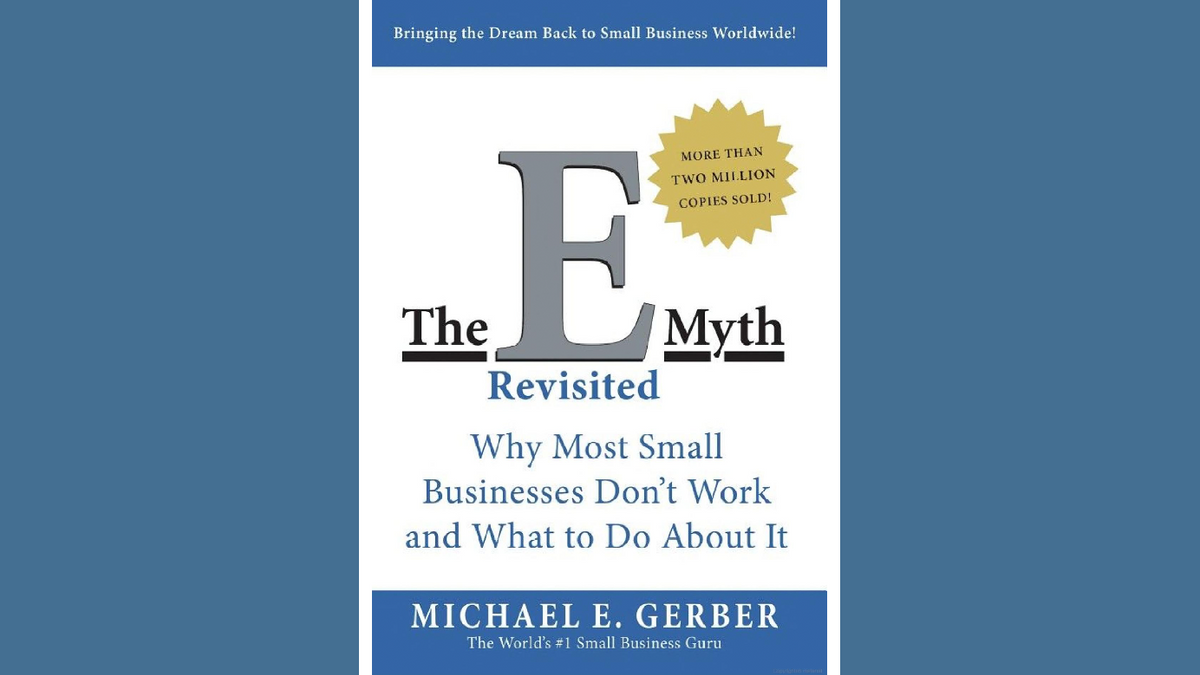How Have I Not Read The E-Myth Before?
A book I wish I had found on Dad's bookshelf a bit earlier, and a story from the Navy.

The E-Myth Revisited is one of those books you might grab from your Dad's bookshelf and after tearing through it, ask yourself, "How have I not read this before?" It's that good. Shouldn't Dad have put it in my supplemantary summer reading list as a kid? Why didn't he slot this one in between The 7 Habits of Highly Effective People and The Monk and The Riddle?
Alas, I had to stumble upon it myself during an uproductive evening's scroll through some standard YouTube Productivity Porn. This book has been making the rounds on those channels. My friends Nick and Noah had already podcasted about it even!
And of course when I told my Dad that I was reading it, he responded by rattling off a quote about the fierce and ever-present struggle experienced by technicians, managers, and entrepreneurs of a company. Timmy Talk thrives!
My main take aways from this book are:
- The roles and behaviors of the technician, the manager, and the entrepreneur. "Put another way, while The Entrepreneur dreams, The Manager frets, and The Technician ruminates."
- Working ON your business versus working IN your business and a great rant on franchises - "you just bought yourself a job!"
- Treating business as a process to be designed, innovated, and maintained. "What you do in your model is not nearly as important as doing what you do the same way, each and every time."
The Technician, The Manager, The Entrepreneur
I loved this model for a business as it really simplifies how to think about how people in an organization behave and why they do what they do. My experience as a Naval Officer firmly resides in the land of Middle Manager, and I think I spent a large portion of my early years focused on what I wanted to achieve without fully accounting for what the technicians and the entrepreneur wanted to achieve.
The technician lives in the present and builds the widgets that the company makes. He wants to be left alone to build things. He gets upset when the manager adjusts timelines or audits processes.
The manager lives in the past and manages the technicians. He likes to create and manage metrics, which he uses to identify problems and acribe fixes. The manager finds cures for problems and often worries about how to push strategic objectives and decisions to lower levels. He wonders if the technician understands the plan.
The entrepreneur lives in the future and carries the vision for the business. His ultimate goal is for the business to operate without him!
To The Manager, then, The Technician becomes a problem to be managed. To The Technician, The Manager becomes a meddler to be avoided. To both of them, The Entrepreneur is the one who got them into trouble in the first place!
The Entrepreneur wakes up with a vision. The Manager screams “Oh, no!” And while the two of them are battling it out, The Technician seizes the opportunity to go into business for himself.
Work ON Your Business Not IN Your Business
This concept seems obvious once you read it, but it gets at the heart of why so many small businesses fail. Essentially, the entrepreneur has a vision, but locks himself in the role of the technician or manager forever, believing he has some sort of magic which requires his presence at that level.
“If your business depends on you, you don’t own a business—you have a job. And it’s the worst job in the world because you’re working for a lunatic!”
It reminds me of a phrase in the Navy we use "Does it pass the bus test?" Have I designed a plan and process well enough that it would continue to functioneven if I were run over by a bus today?
Treat Business as a Process to be Designed, Innovated, and Maintained
By recognizing that it is not the commodity that demands Innovation but the process by which it is sold, the franchisor aims his innovative energies at the way in which his business does business.
Anybody can build a widget, but it's the process by which a business builds and sells the widget where a business achieves success or failure. I've been thinking a lot lately about how it's pretty much impossible to be 100% organized 100% of the time.
To make art, you have to pull out paper, pencil, paints, something to put the paints in, a paintbrush, easel, etc. After making a painting, you must clean the brushes, put the paints away, wash your clothes. In order to create somehting, you must disturb order.
Another way I like to think about it is through the lens of entropy. The second law of thermodynamics states that the universe tends toward disorder, or increasing entropy. In his book, The Gene, one of my all-time favorites, Siddhartha Mukherjee postulates that perhaps it is the job of biological life to try and establish order, or reduce entropy, from this chaos. I just love that dichotomy.
What it all gets down to is an understanding of what mess needs to be made to create something, and how to minimize how big that mess is and how to clean it up properly. Think SOPs, onboarding, and documentation. (Does this spark joy? 😂) Once the entrepreneur has his vision, it now becomes his job to create a business that maintains that vision without him. It requires strict processes and a strong focus on education of employees.
I really loved Micahel Gerber's view on hiring employees who are the LEAST qualified. Typically, we think we want to hire the MOST qualified person. Here's his take:
Only when the Sales Operations Manual is complete does Murray run an ad for a salesperson. But not for someone with sales experience. Not a Master Technician. But a novice. A beginner. An Apprentice. Someone eager to learn how to do it right.
And the ad is placed under Sales in the Classified Section of the Sunday paper. It reads: COME AND SEE OUR TURN-KEY OPERATION. COME AND SEE OUR MONEY MACHINE. NO EXPERIENCE NECESSARY. JUST AN OPEN MIND AND A WILLINGNESS TO LEARN. And as Murray interviews the candidates, he shows them the Sales Operations Manual and Widget Makers’ Strategic Objective, and explains how they were created and why.
“He seemed to be saying that what we were going to talk about was the most important thing on his agenda that day, that discussing my job was more important to him than doing the work that was going on at the time. “He wasn’t hiring me to work; he was hiring me to do something much more important than that.”
A Story From My Time in the Navy
One of my most difficult experiences as a young Naval Officer involved biological fouling of heat exchanger U-tubes in the submarine's main condensers. The steam produced by hot nuclear reactor water which we use to spin turbines for propulsion and electricity is condensed back to liquid by two gigantic heat exchangers with cold-ish seawater. Little ocean critters like barnacles, crabs, and even tiny fish really seem to be attracted to (or sucked up by) these warm U-tubes such that they required frequent cleaning.
The tool used to clean the tubes is called a hydrolancer which is essentially a very small diameter firehose. Operating the tool requires three men: one to operate the pressure rig, one to push the hose through and pull it back out, and one assistant. Of note, extreme caution is required as misguiding the high pressure hose can (and did) cause severe lacerations or amputations of fingers. The below image should help you picture it.
Anytime we sat in port for more than a couple weeks while operating the main condensers, we had to clean the U-tubes before going out to sea. There were some tricks to try and get around it like putting the condensers in lay up (fill 'em and leave 'em) and attaching a chlorinator when they were in operation (bleach the bastards). Unfortunately, the biological fouling seemed to come about even with those measures. We were only allowed to put a tiny amount of bleach for envronmental reasons too. Ocean critters are hardy critters. Have you ever watched a crabget pummeled over and over by the surf or tried to scrape a barnacle off a rock?
My job was clear enough, make sure the main condensers are hydrolanced efficiently so that we can get underway on time. But how to go about that was a different beast entirely. There are hundreds if not thousands of those tiny tubes and lancing them takes time. In addition to that, many other submarine systems were being put back together at this time, such that my 15 mechanics were needed for all sorts of pipe fitting and valve turning. They were a hot commodity and taking even 3 of them away propted a difficult personel problem.
I started by gathering some numbers. I hit the basics first. How many tubes are there? How long does it take on average to hydrolance 1 tube? Then I drilled a bit deeper. After accounting for other projects, requirements, and leave, how many available mechnics do I actually have?
In addition to getting the condensers cleaned, the problem also involved maximizing quality of life for my sailors such that they can spend the minimum amount of time at work before we would go out to sea.
My initial plan revolving around a normal work schedule and whoever was available, which quickly torn apart by the Commanding Officer. My first review did not go well. I sustained some verbal onslaughts I did not want to sustain again.
Chief and I put our heads together, along with input from the sailors, and managed to come up with a shiftwork plan for 24/7 hydrolancing. We saw some great efficiency and speed gains in being able to perform work outside of normal working hours and the craziness that a normal day onboard a submarine brings. Moreover, the guys who volunteered for the night shift seemed to prefer working with more solitude. Not everybody wants to work nights so we had to tread carefully here.
We all still hated hydrolancing, but we had figured out how to get it done in 3 days instead of 8 and in a way that seemed to please the most people. On top of that, since hydrolancing was a recurring event for us, the general strategy continued to be refined such that my mechnics were all able to attend required training and be "in the know" about the goings on of day-walker business.
We even codified our hydrolancing plan in a manilla folder populated with calendars, time tables, metrics, and best practices for future use. Rather than sit down in a 45 minute meeting with the CO where I risked verbal assault and emotional anguish, I just presented the same old plan to his inbox which he would sign and return. I had bounced back and forth between my technicians and the entrepreneur and emerged with a repeatable process.
A s a manager I have a unique role operating at an intermediate level between technicians (mechanics, electricians, torpedomen, etc) and the entrepreneur (in my case, the commanding officer. In his case, the deputy and/or admirals, and up from there). If I had spent more time understanding the motives of the technicians and the entrepreneurs, I imagine I would have had a smoother time of things.



